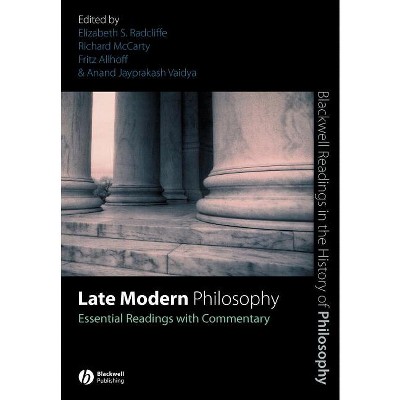Sponsored

Building Science - by Jens Pohl (Mixed Media Product)
In Stock
Sponsored
About this item
Highlights
- With the improved efficiency of heating, cooling and lighting in buildings crucial to the low carbon targets of all current governments, Building Science: Concepts and Applications provides a timely and much-needed addition to the existing literature on architectural and environmental design education.
- About the Author: Jens Pohl, PhD, is Professor of Architecture and Graduate Studies Coordinator, Executive Director of the CAD Research Center (CADRC), College of Architecture and Environmental Design, California Polytechnic State University, San Luis Obispo, California.
- 288 Pages
- Architecture, Design, Drafting, Drawing & Presentation
Description
Book Synopsis
With the improved efficiency of heating, cooling and lighting in buildings crucial to the low carbon targets of all current governments, Building Science: Concepts and Applications provides a timely and much-needed addition to the existing literature on architectural and environmental design education. Taking a logical and didactic approach, the author introduces the reader to the underlying concepts and principles of the thermal, lighting, and acoustic determinants of building design in four integrated sections.The first section explores the thermal building environment and the principles of thermal comfort, translating these principles into conceptual building design solutions. The author examines the heat flow characteristics of the building envelope and explains steady state design methods that form the basis of most building codes. He discusses the sun as a natural heat source and describes the principles of active and passive solar building design solutions.
The second section introduces the scientific principles of light, color, and vision, stressing the importance of daylight in building design, presenting the Daylight Factor design concept and methodology, and discussing glare conditions and their avoidance. It also addresses artificial lighting, delving into the prominent role that electricity plays in the production of light by artificial means and comparing the efficacy and characteristics of the various commercially available light sources in terms of the energy to light conversion ratio, life span, available intensity range, color rendition properties, and cost.
The third section deals with the various aspects of sound that impact the design of the built environment, discussing the nature of sound as a physical force that sets any medium through which it travels into vibration and laying the foundations for the treatment of sound as an important means of communication as well as a disruptive disturbance.
The final section discusses the foundational concepts of ecological design as a basis for addressing sustainability issues in building design solutions. These issues include the embedded energy of construction materials, waste management, preservation of freshwater and management of graywater, adoption of passive solar principles, energy saving measures applicable to mechanical building services, and the end-of-lifecycle deconstruction and recycling of building materials and components.
- Covers the fundamental building science topics of heat, energy, light and sound
- Takes a logical and didactic approach, tracing the historical roots of building science
- Includes summaries of new technologies in solar energy and photovoltaic systems
- Features a section on the principles of sustainable architecture
- Website with answers to MC questions testing students' learning
From the Back Cover
With the improved efficiency of heating, cooling and lighting in buildings crucial to the low carbon targets of all current governments, Building Science: concepts and applications provides a timely and much-needed primer on the key concepts of heat, energy, light and sound.Taking a logical and didactic approach, the author introduces the reader to the underlying concepts and principles of the thermal, lighting, and acoustic determinants of building design in four integrated sections.
The first section explores the thermal building environment and the principles of thermal comfort, translating these principles into conceptual building design solutions. The author examines the heat flow characteristics of the building envelope and explains steady state design methods that form the basis of most building codes. He discusses the sun as a natural heat source and describes the principles of active and passive solar building design solutions.
The second section introduces the scientific principles of light, color, and vision, stressing the importance of daylight in building design, presenting the Daylight Factor design concept and methodology, and discussing glare conditions and their avoidance. It also addresses artificial lighting, delving into the prominent role that electricity plays in the production of light by artificial means and comparing the efficacy and characteristics of the various commercially available light sources in terms of the energy to light conversion ratio, life span, available intensity range, color rendition properties, and cost.
The third section deals with the various aspects of sound that impact the design of the built environment, discussing the nature of sound as a physical force that sets any medium through which it travels into vibration and laying the foundations for the treatment of sound as an important means of communication as well as a disruptive disturbance.
The final section discusses the foundational concepts of ecological design as a basis for addressing sustainability issues in building design solutions. These issues include the embedded energy of construction materials, waste management, preservation of freshwater and management of graywater, adoption of passive solar principles, energy saving measures applicable to mechanical building services, and the end-of-lifecycle deconstruction and recycling of building materials and components.
WEBSITE:
A companion website for the book offers freely downloadable resources for students and lecturers:
Multiple Choice questions and answers: allow students to test their understanding of the concepts and principles of climate, heat, light, and sound, as well as their application in the design and construction of buildings.
Power Point slides: have been prepared for lecturers to highlight the underlying fundamental principles pertaining to the environmental aspects of building science, with some practical examples from the natural and built environment.
Cover design by Andrew Magee
About the Author
Jens Pohl, PhD, is Professor of Architecture and Graduate Studies Coordinator, Executive Director of the CAD Research Center (CADRC), College of Architecture and Environmental Design, California Polytechnic State University, San Luis Obispo, California.Shipping details
Return details
Trending Non-Fiction











